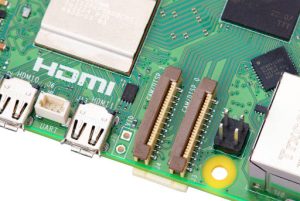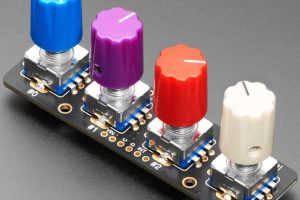
Twice the speed of Raspberry Pi 4 is promised (to 2.4GHz), from the new 16nm quad Cortex-A76 processor, and dual 4Kp60 display capability.
One very important upgrade is that this Raspberry Pi has the hardware security features now so important to network-attached embedded computers.
Two other notable addition to Raspberry Pi in its fifth incarnation are an available PCIe interface (2.0 x1) – that has proved so popular on the Raspberry Pi Compute Module 4 – for fast peripherals, and an on-board real-time clock (external battery required).
Available for pre-order now, RPi 5s are scheduled to ship at the end of October and will remain in production until at least January 2035
Prices are:
$60+tax for 4Gbyte variant
$80+tax for 8Gbyte variant
Another new thing is that “it’s the first Raspberry Pi computer to feature silicon designed in‑house here in Cambridge, UK,” said Raspberry Pi CEO Eben Upton.

He is talking about the RP1 IO controller, analogous to the ‘southbridge’ chips that used to inhabit PCs, that provides USB, Ethernet, MIPI (camera and display) and 3.3VGPIO, plus UART, SPI, I2C, I2S and PWM. Connection back to the main CPU (Broadcom’s BCM2712) is at 16Gbit/s via four-lane PCI Express 2.0.
Designed by the same team that created the RP2040 MCU and made on TSMC’s 40LP process, RP1 apparently cost $15m to develop.

That Broadcom CPU needs a 20A supply to operate, which is provided by a single Renesas multi-channel dc-dc converter chip (DA9091), that also provides the board’s other power rails.
Peak consumption is predicted to be ~12W, although “Raspberry Pi 5 consumes significantly less power, and runs significantly cooler, than Raspberry Pi 4 when running an identical workload”, according to the organisation. “However, the much higher performance ceiling means that for the most intensive workloads peak power consumption increases versus 8W for Raspberry Pi 4.”
A blown heatsink (above left) is an option from day one, as is a Raspberry Pi themed case with an integrated fan (above right) .
 Mechanical update
Mechanical update
The four-pole composite video and analogue audio jack has gone, with the video (generated by the RP1) available from a pair of 0.1in vias (photo left).
A pair of flexi-PCB (‘FPC’) connectors deliver the four-lane MIPI interfaces – as they do on Compute Module I/O boards. Each can connect either to a CSI-2 camera or to a DSI display.
The PCI Express 2.0 high-speed peripherals bus gets its own flexi connector, placed where Raspberry Pi 4 has its flexi display connector.
Raspberry Pi 5 has:
- 2.4GHz quad-core 64-bit Arm Cortex-A76 (Broadcom BCM2712)
cryptography extensions, 512Kbyte per-core L2 caches and a 2MB shared L3 cache - LPDDR4X-4267 SDRAM (4 and 8Gbyte at launch)
- Dual 4Kp60 HDMI display output with HDR support
VideoCore VII GPU supporting OpenGL ES 3.1, Vulkan 1.2
4Kp60 HEVC decoder - Dual-band 802.11ac Wi-Fi
Bluetooth 5.0 and Bluetooth Low Energy - Gigabit Ethernet, with Power-over-Ethernet (PoE+) support (requires separate HAT-format add-on board)
- PCIe 2.0 x1 interface (there will be an M.2 HAT for M.2 accessories like NVMe SSDs)
- microSD card slot, with support for high-speed SDR104 (104Mbyte/s) mode
- Two USB 3.0 ports, supporting simultaneous 5Gbit/s operation
Two USB 2.0 ports - Dual 4-lane MIPI camera/display transceivers
- DC power via USB-C (5V 5A) with Power Delivery support
- Real-time clock (needs external battery)
- Power button
- Standard 40pin IO header
 Electronics Weekly Electronics Design & Components Tech News
Electronics Weekly Electronics Design & Components Tech News



